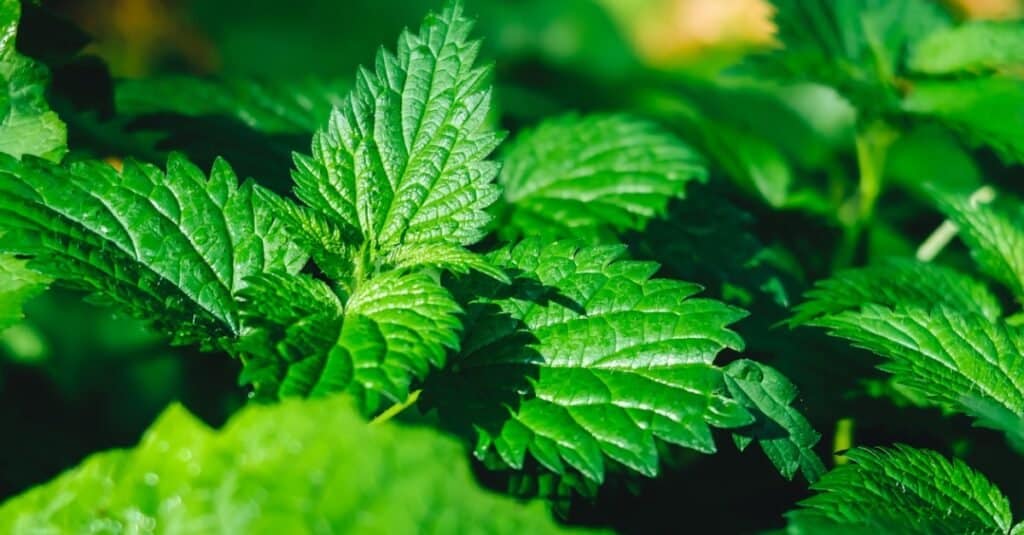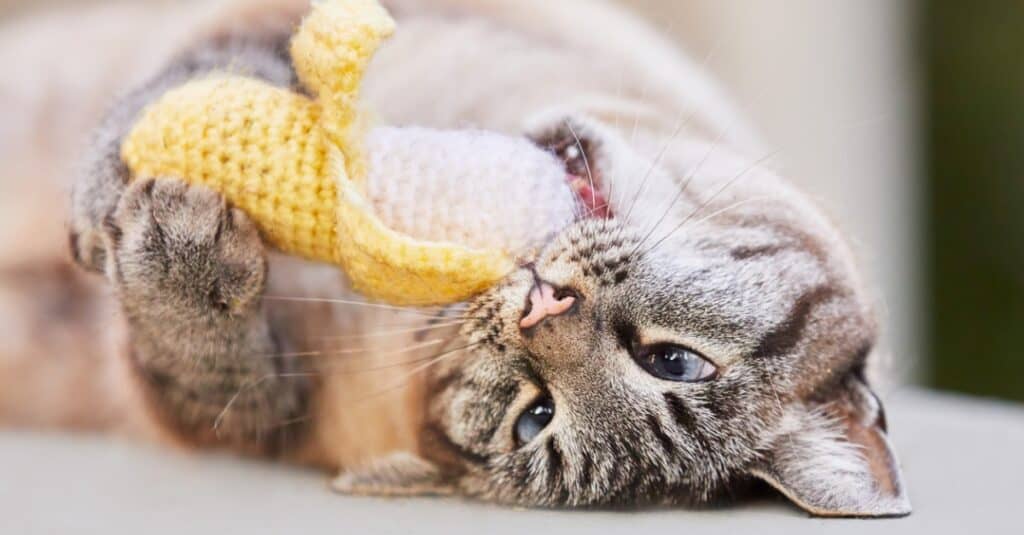Cat owners love to see the reaction of their cat when it encounters catnip. Most felines love it and show it in crazy ways that include rubbing against everything, pawing random objects, rolling around, and just generally acting strange. Catnip makes your favorite feline act like a cat in heat, although it affects males and females equally. It can turn a docile cat into a wigged-out lunatic within a matter of seconds. But what exactly is catnip, and why does it affect some felines and not others?
Catnip is an Herb

©Attila Fedyk/Shutterstock.com
This fragrant plant, with the scientific name Nepeta cataria, is a member of the mint family. It’s also called catmint or catswort and is native to Europe, Asia, and Africa, although it is also found throughout North America. This perennial herb has more than 250 species worldwide. It can grow as tall as three feet, exhibiting sturdy steams with heart-shaped leaves and saw-toothed edges. Blue, white, pink, or purple flowers bloom from late spring into autumn. Gardeners often incorporate it into their flowerbeds because catnip is drought-tolerant, deer resistant, and a mosquito deterrent. In addition to making cats go crazy, it also attracts butterflies.
Catnip’s Active Ingredient
Catnip’s essential ingredient is a substance called nepetalactone, an oil contained in the plant’s leaves and stems. Cats have an extra scent organ called the vomeronasel gland in the roof of their mouth. This special pathway allows scents that are collected in the nose and mouth to be carried to the brain. Nepetalactone in catnip stimulates pheromone receptors in a cat’s nose, providing a chemical reaction that gives the animal a sense of euphoria. The effect is similar to how humans react to a hallucinogenic drug. The odor of nepetalactone sends signals to the olfactory bulb in an animal’s brain for processing, heading toward the amygdala, which controls emotions, and the hypothalamus, which regulates body functions.
When felines smell catnip, they will rub it, paw at it, lick it, eat it and roll over in it. Individual animals with extreme reactions to catnip may meow, growl, purr, get frisky, shake their heads, drool, and generally act wild. Some cats look like they are getting stoned or having some kind of drug trip. Although researchers don’t know precisely what cats experience, they know that smelling catnip results in a release of beta-endorphins, natural opioids produced by the body. When cats’ opioid receptors are blocked, they don’t respond in the same way, indicating that endorphins are responsible for their crazy behavior.
Neither do cats seem to become addicted to the plant. Most cats will know when they have had enough and will walk away from it. For the few felines who eat too much of it, they may experience stomach upset, vomiting, or diarrhea, but no other ill effects. As long as your pet takes a break from catnip, her body will return to a state of balance.
Why Doesn’t My Cat Like Catnip?
Not all cats are attracted to the odor of catnip. Estimates indicate that about 50% to 80% of domestic cats experience effects from the herb’s odor. Cats appear to inherit this trait. For example, most Australian domestic cats do not show behavior effects when exposed to catnip. Young kittens and older cats do not respond well to it. Researchers theorize that cats have evolved to love the herb because it may protect them from mosquitos and parasites.
Catnip’s odor affects more than just housecats. Large, wild cats like lions, tigers, and leopards, exhibit similar behavior when exposed to it. Nepetalactone also affects mosquitos, flies, cockroaches, and termites away with its odor and is 10 times more effective than DEET. However, nepetalactone is not a candidate for use in insect repellants as it loses its effectiveness when applied to human skin.
Nepetalactone also affects aphids as a sex hormone as they like to such the sap of catnip plant. At the same time, the pheromone also attracts aphid predators like the lacewing fly, ultimately protecting the plant.
Other Plants and Animals Have a Similar Effect on Cats
Catnip isn’t the only plant that can send cats into frenzied behavior. Silvervine, which contains a compound called neptalactol, can similarly affect cats. This plant is a species of kiwifruit in the Actinidiacae family of flowering plants. Valerian and Tartarian honeysuckle wood also have similar properties.
Oddly enough, mice produce lactones, molecules similar to nepetalactone in their sweat. They may have evolved in this way to distract cats when they get caught, and it could explain why cats often bat around and play with mice, similar to the way they do when encountering a toy mouse stuffed with catnip.
Giving Your Cat Catnip

©iStock.com/Svetlana Popova
Pet owners will find all kinds of catnip products in shops and online. You can find them as part of toys, in pouches, or even loose, giving you the ability to sprinkle the herb for your kitty wherever you desire. You can even grow your catnip to give your cat a ready supply. Fresh catnip is more potent than dried – so you won’t need to give your cat as much.
Catnip is helpful as a training aid. Sprinkling catnip around certain objects will encourage your cat to use items such as scratching posts, litterboxes, bedding, or cat carriers.
The type of catnip will also affect the intensity of your pet’s experience. Give your cat either fresh or dried catnip, but if you intend to have an ample supply, keep it in an airtight container in the freezer to prevent its essential oils from dissipating quickly and preserve its potency. You may be tempted to try commercial catnip sprays, but these products are not as effective as fresh or dried catnip as they don’t have as much nepetalactone.
Don’t fret if your cat accidentally eats a little catnip – it may even be helpful for their digestive tract. However, it is important to keep your cat from ingesting large amounts of catnip, as it can cause an upset stomach.
Other Uses for Catnip
Because it’s an herb, catnip has long been used as natural medicine. When made into a tea or an infusion, it acts as a mild sedative and provides a soothing and numbing effect. Its historical uses include it as a remedy for nausea, headaches, and toothaches.
Up Next…
- The Best Interactive Cat Toys for 2022 – Reviewed and Ranked: Keep your kitty entertained with these great interactive toys!
- All Of Your Cat’s Crazy Behaviors, Explained: One of the fun things about having a cat is their unpredictability! Find out why they can act so crazy!
- Why Do Cats Eat Grass, and What Should You Do About It?: They seem to do it instinctively, but why do cats eat grass? Find out here!
- Here are Our Top Choices for Best Cat Harnesses: Thinking about taking your indoor kitty on an outdoor adventure? Check out our picks for best cat harnesses!
The photo featured at the top of this post is © Lightspruch/Shutterstock.com
Thank you for reading! Have some feedback for us? Contact the AZ Animals editorial team.







